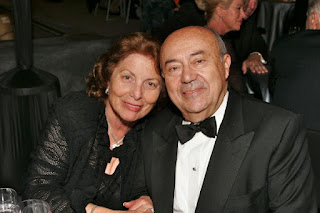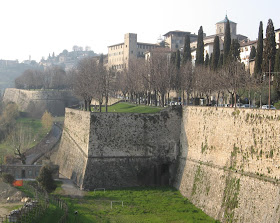NEW - Andrew Viterbi – electrical engineer and businessman
The amazing life of 'the father of the mobile telephone'
Andrew Viterbi, who invented the Viterbi algorithm and co-founded the American multinational corporation Qualcomm, was born Andrea Giacomo Viterbi on this day in 1935 in Bergamo in the Lombardy region of Italy. The Viterbi algorithm is still used widely in cellular phones and other communication devices for error correcting codes as well as for speech recognition, DNA analysis and other applications. Viterbi also helped to develop the Code Division Multiple Access standard for cell phone networks. He is recognised in Italy as ‘il padre del telefonino’ - the father of the mobile telephone. Viterbi’s father, Achille, was director of Bergamo Hospital’s ophthalmology department, and his mother, Maria Luria, came from a prominent family in Piedmont and had a teaching degree. But after Mussolini introduced his new racial laws in Italy before the start of World War II, the couple, who were both Jewish, were deprived of their position and could no longer make a living to support their family. They had planned to sail to the United States on 1 September, 1939, but after receiving a tip-off alerting them to possible danger, they secretly escaped two weeks early and were able to land safely in New York. Read more…
_____________________________________
Nabucco premieres in Milan
Verdi opera that became a symbol of the Risorgimento
The opera Nabucco, with music by Giuseppe Verdi and a libretto by Temistocle Solera, was first performed on this day in 1842 at Teatro alla Scala in Milan. The opera contains the famous chorus Va, pensiero, a lament for a lost homeland that many Italians now regard as their unofficial national anthem. The opera and Verdi himself have become synonymous with the Risorgimento, the period in the 19th century when people worked to free the Italian states of foreign domination and unite them under the leadership of Victor Emmanuel, the King of Sardinia and Duke of Savoy. It is said that during the last years of the Austrian occupation of Lombardia and the Veneto, for example, that Italian patriots adopted Viva Verdi as a slogan and rallying call, using the composer’s name as an acronym for 'Vittorio Emanuele Re d’Italia' - 'Victor Emmanuel, King of Italy'. On the day of the composer’s funeral in Milan in 1901, a crowd of 300,000 people filled the streets and sang Va, pensiero, conducted by Arturo Toscanini, a moving event that showed how Verdi’s music had helped unite the Italian nation. But Verdi nearly didn’t take up the offer to compose the music for Nabucco. Read more…
_____________________________________
Amerigo Vespucci – explorer
Medici clerk who discovered a new world
Explorer and cartographer Amerigo Vespucci was born on this day in 1454 in Florence. Vespucci was the first to discover the ‘new world’, which later came to be called the Americas, taking the Latin version of his first name. He was the son of a notary in Florence and a cousin of the husband of the beautiful artist’s model, Simonetta Vespucci. He was educated by his uncle, Fra Giorgio Antonio Vespucci, a Dominican friar, and he was later hired as a clerk by the Medici family. He acquired the favour of Lorenzo di Pierfrancesco de' Medici, who sent him to the Medici office in Cadiz in Spain to investigate the managers, who were under suspicion. Later, as the executor of an Italian merchant who had died in Seville, Vespucci fulfilled the deceased’s contract with Castile to provide 12 vessels to sail to the Indies. He then continued supplying provisions for expeditions to the Indies and was invited by the King of Portugal to participate as an observer on several voyages of exploration. Although letters have been forged and fraudulent claims have been made about his discoveries, Vespucci is known to have taken an active part in at least two real voyages of exploration. Read more…
____________________________________
Bettino Ricasoli - statesman and winemaker
Prime minister and inventor of modern Chianti wine
The politician and winemaker Barone Bettino Ricasoli was born on this day in 1809 in Florence. Ricasoli, who is considered one of the driving forces of the Risorgimento alongside Giuseppe Mazzini, Count Camillo Benso of Cavour, Giuseppe Garibaldi and others, succeeded Cavour as prime minister in 1861, the second person to hold the office in the new Kingdom of Italy. After withdrawing from politics, he concentrated on the family vineyards around the Castello di Brolio in the Tuscan hills between Siena and Arezzo, seat of the Ricasoli family since the early 12th century. It was there in 1872, seeking to create a wine with universal appeal, that he developed the formula for Chianti wine that is still used today, made up of 70 per cent Sangiovese grapes, 15 per cent Canaiolo and 15 per cent Malvasia bianca. Today Barone Ricasoli - the oldest wine producer in Italy and the second oldest in the world - is the largest winery in the Chianti Classico area, with 235 hectares of vines and 26 hectares of olive groves in the area around Gaiole and Castelnuovo Berardenga. Bettino was the son of Baron Luigi Ricasolo and Elisabetta Peruzzi, who came from a family of Tuscan bankers. Read more…
_____________________________________
Internazionale - football superpower
Famous club that broke away from rivals AC Milan
Internazionale, one of Italy's most successful football clubs, came into being on this day in 1908. The winner 18 times of lo scudetto - the Italian championship - the club known often as Inter or Inter-Milan was born after a split within the membership of the Milan Cricket and Football Club, forerunner of the club known now as A C Milan. The original club was established by expatriate British football enthusiasts with a membership restricted to Italian and British players. It was after a dispute over whether foreign players should be signed that a breakaway group formed. Plans for a new club were drawn up at a meeting at the Ristorante L'Orologio in Via Giuseppe Mengoni in Milan, a short distance from the opera house, Teatro alla Scala. It was a restaurant popular with theatregoers and artists, among them Giorgio Muggiani, a painter who would become renowned for his work in advertising, where he designed iconic posters for such clients as Pirelli, Cinzano, Martini and Moto Guzzi. Muggiani, who had developed an enthusiasm for football while studying in Switzerland, was the driving force behind the new club. Read more…
_____________________________________
Emma Bonino – politician
Leading Radical learnt Arabic to understand Middle East press
Veteran politician Emma Bonino, who most recently served as Minister of Foreign Affairs in the Government of Enrico Letta, was born on this day in 1948 in Bra in Piedmont. A leading member of the Italian Radicals, Bonino has throughout her career been an activist for reform policies and a campaigner for women's and human rights. Bonino graduated in modern languages and literature from Bocconi University in Milan in 1972. She founded the Information Centre on Sterilisation and Abortion in 1975 and promoted the referendum that led to the legalisation of abortion in Italy. She was first elected to the Italian Chamber of Deputies in 1976 and was re-elected six times afterwards. In 1986 Bonino was among the promoters of a referendum against nuclear energy, which led to the rejection of a civil nuclear energy programme in Italy. She was appointed minister for international trade in the cabinet of Romano Prodi in 2006 but resigned her post in 2008 after being elected a vice president of the Senate. She had previously been elected to a seat in the Senate on the list of the Democratic party for the Piedmont Constituency. Read more…
Booking.com.jpg)




.jpg)
.jpg)


_-_facciata_1_2019-06-23.jpg)

.jpg)

.jpg)



.jpg)